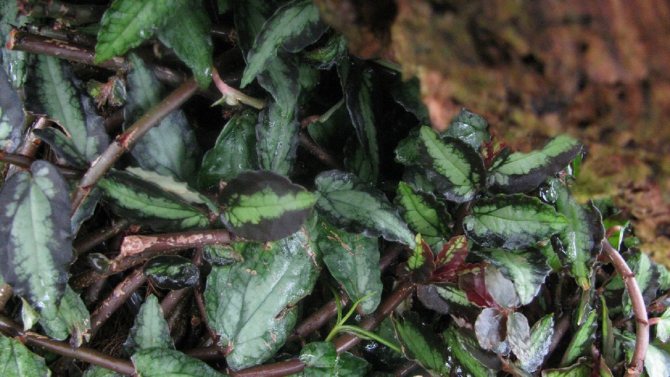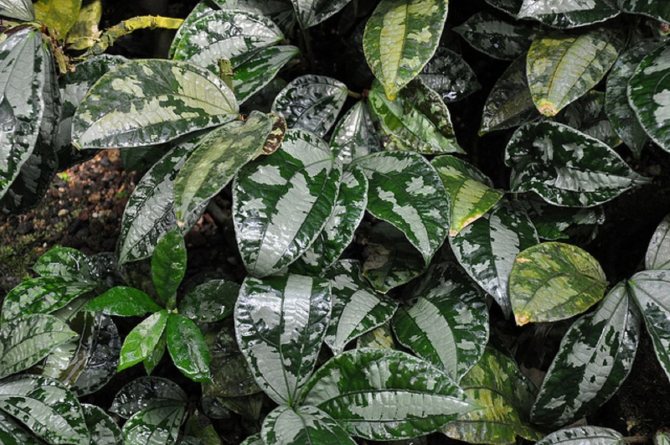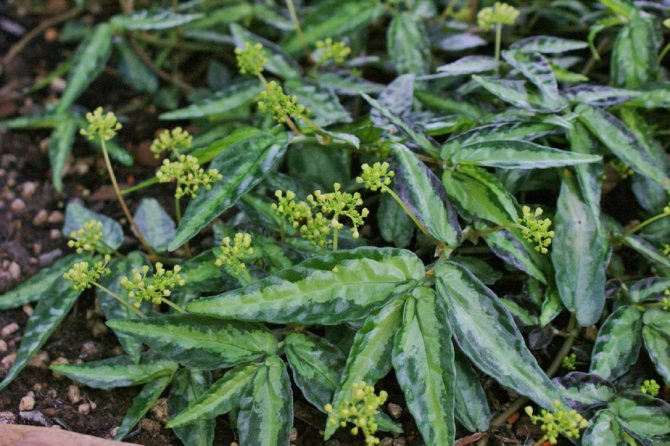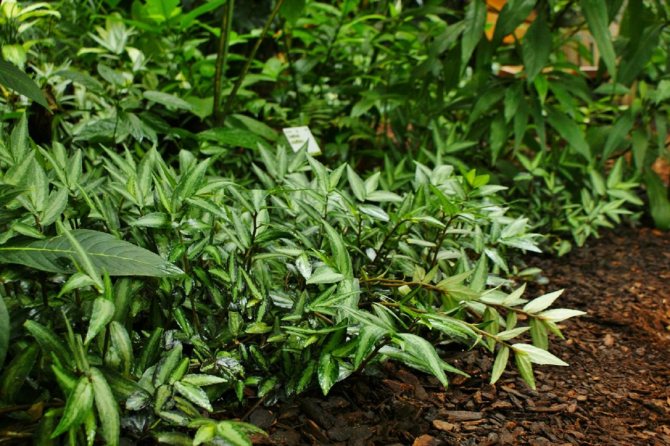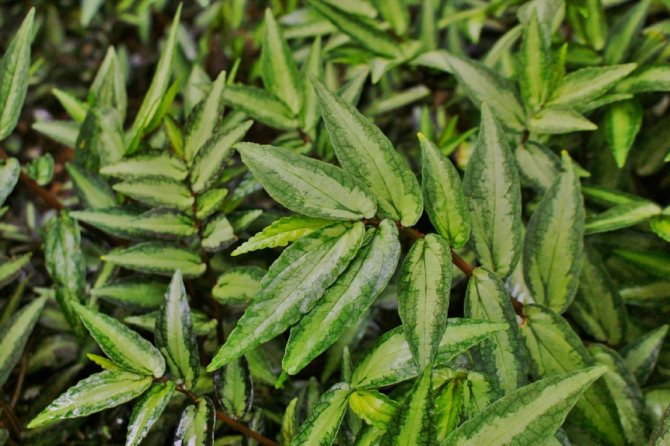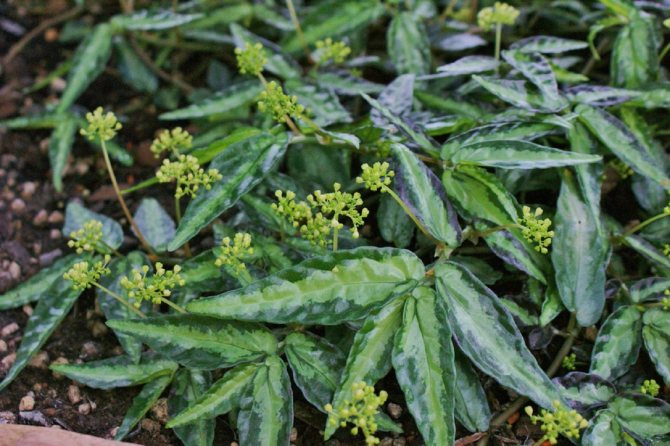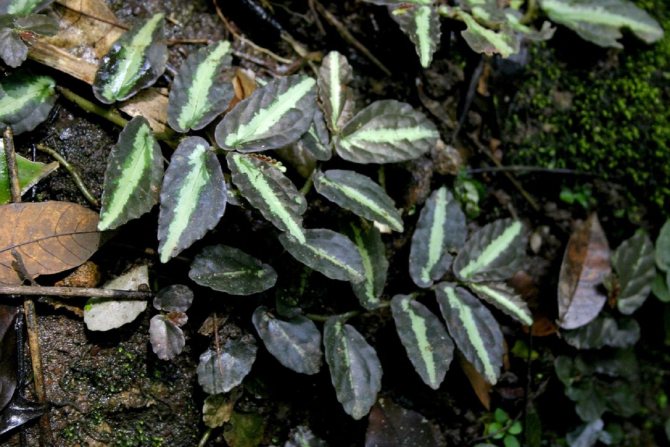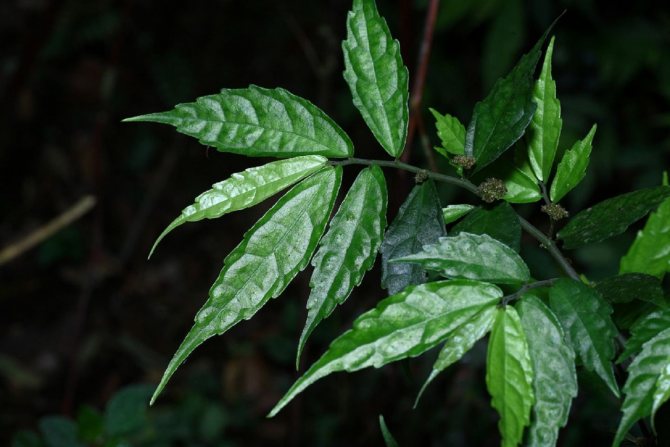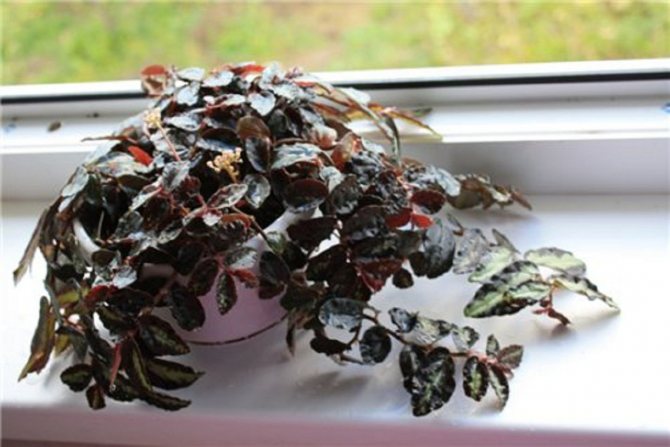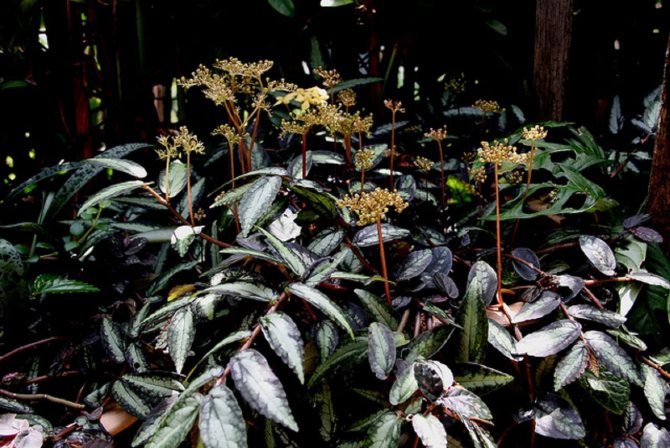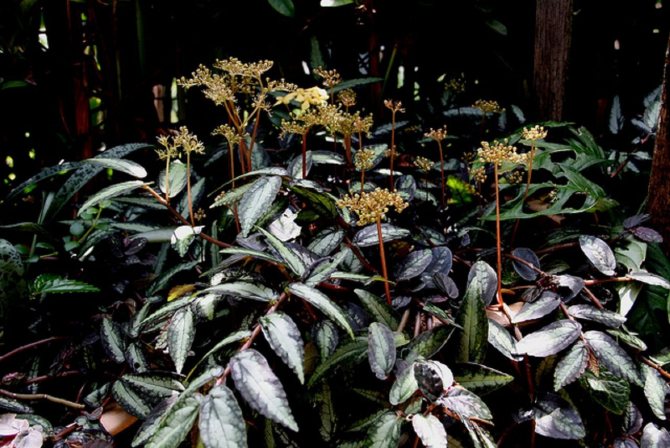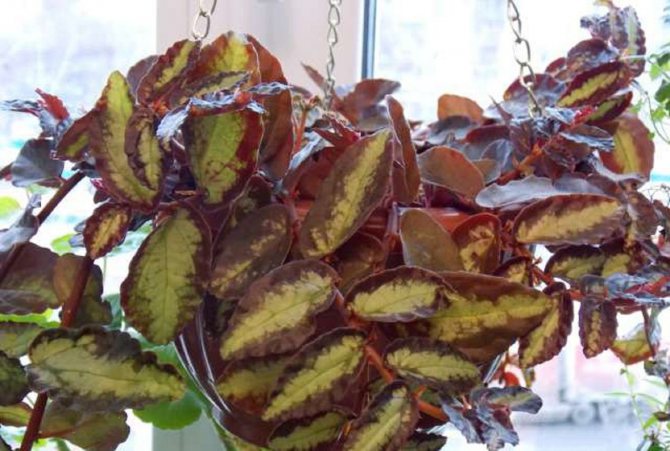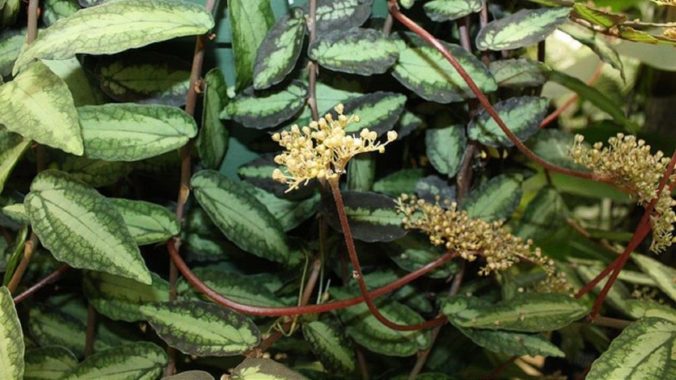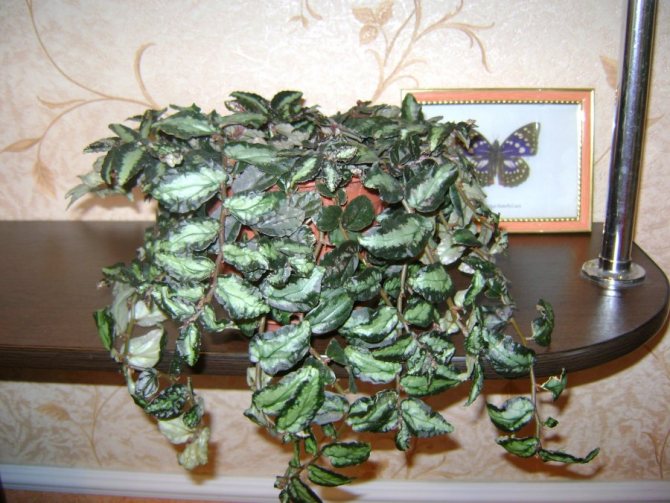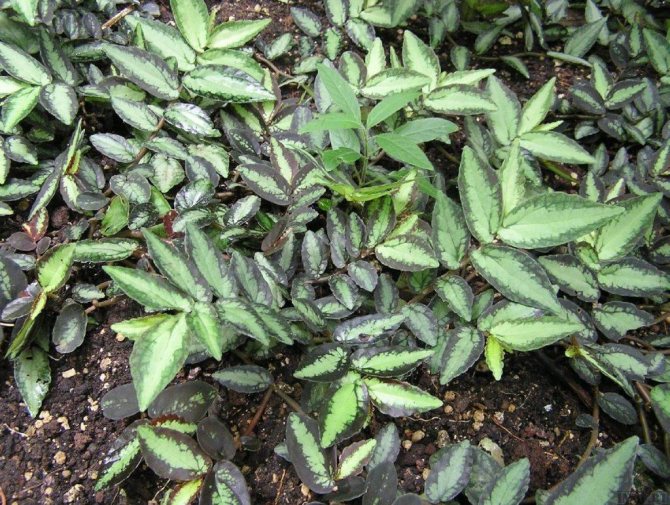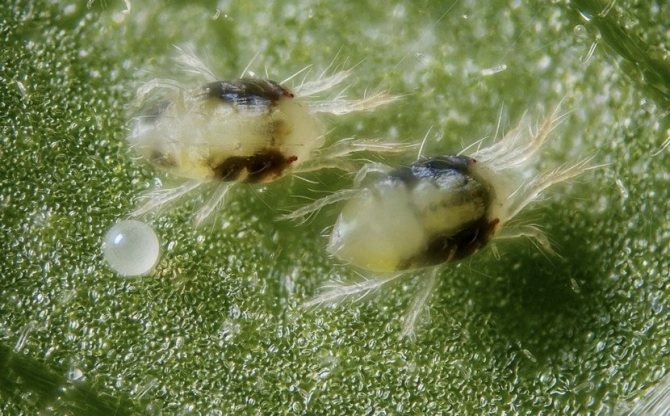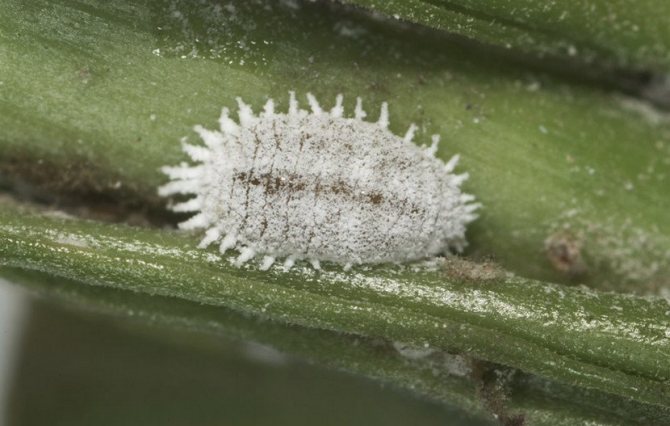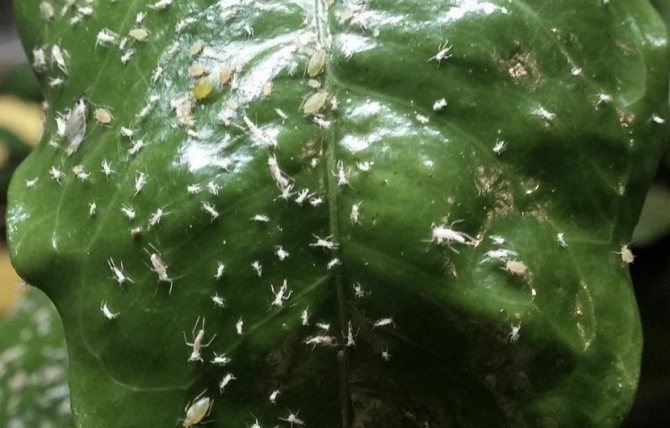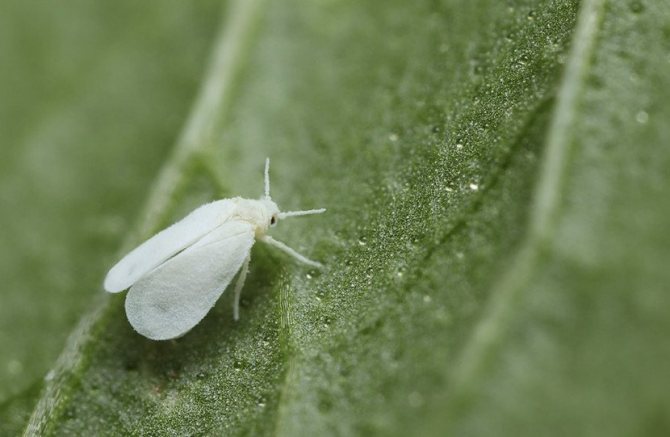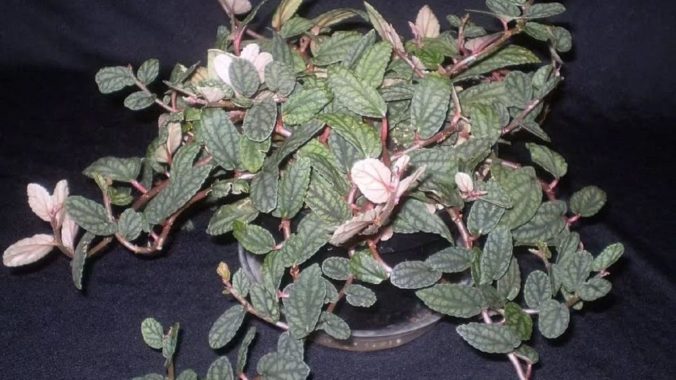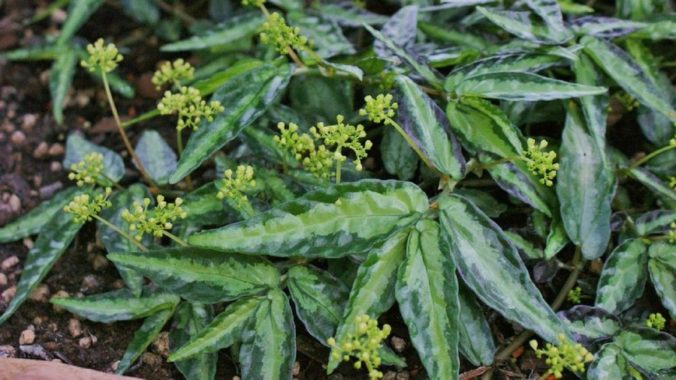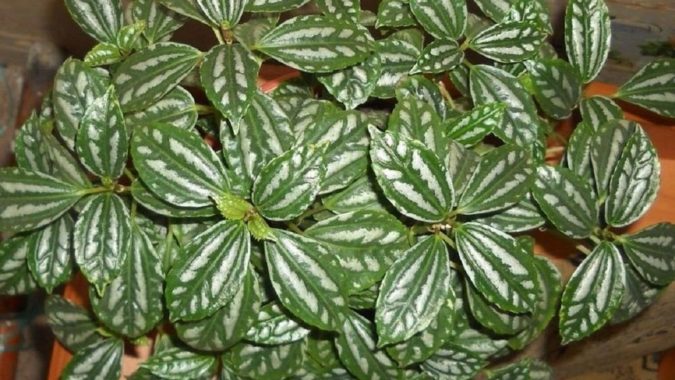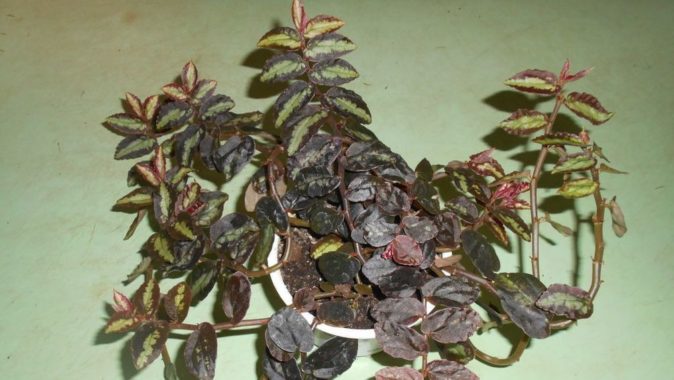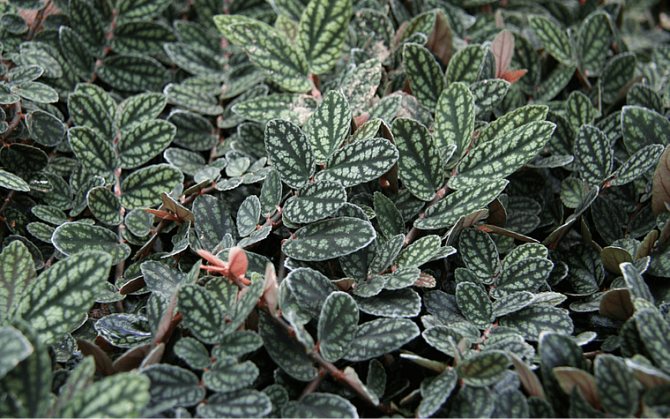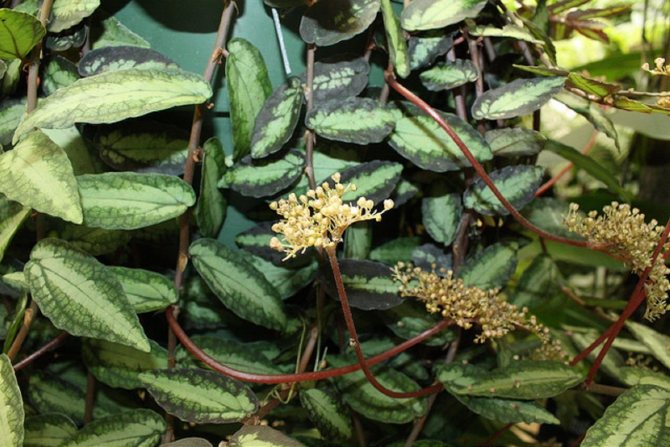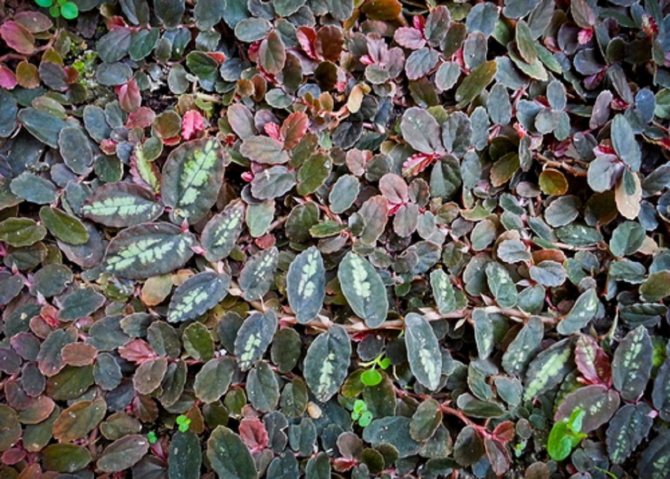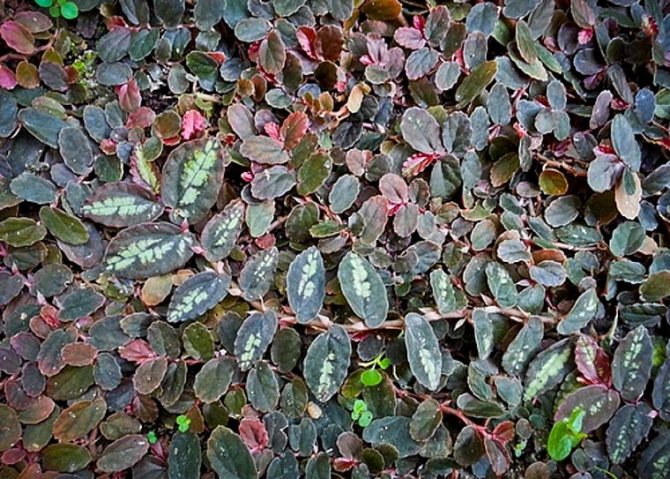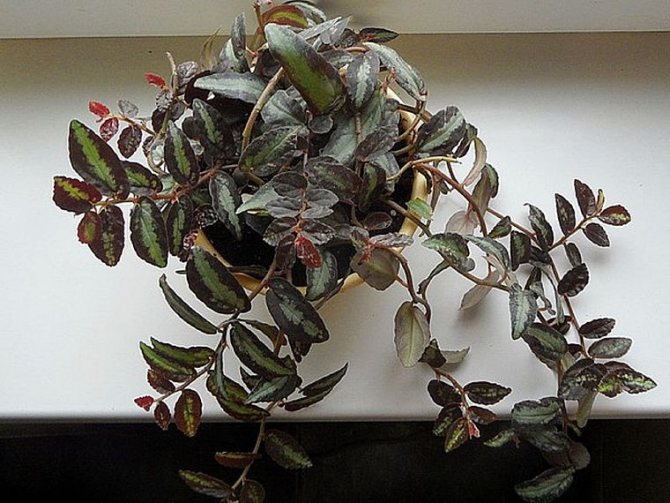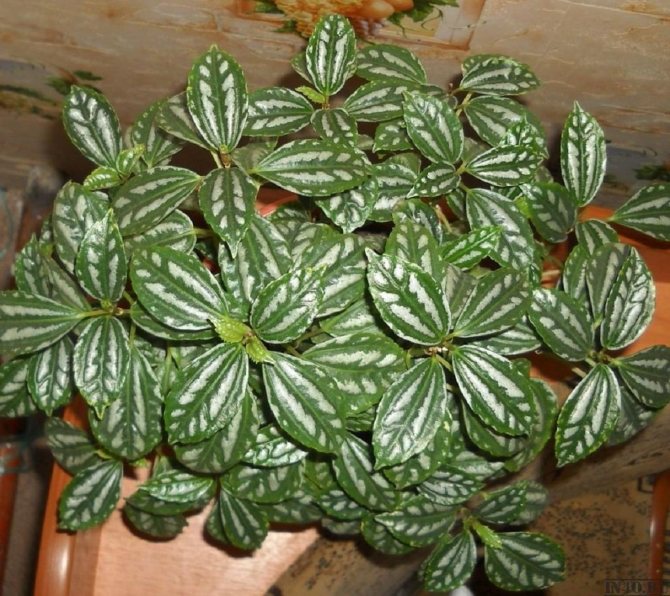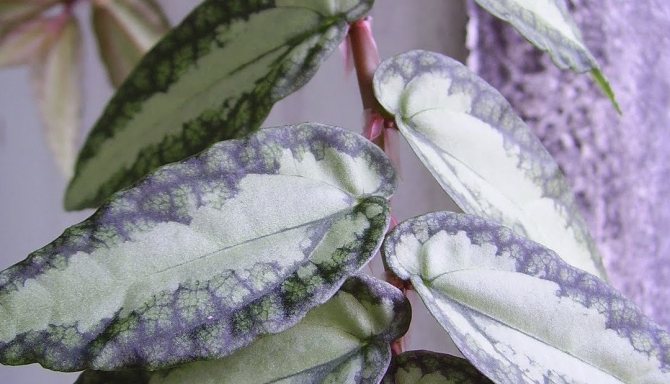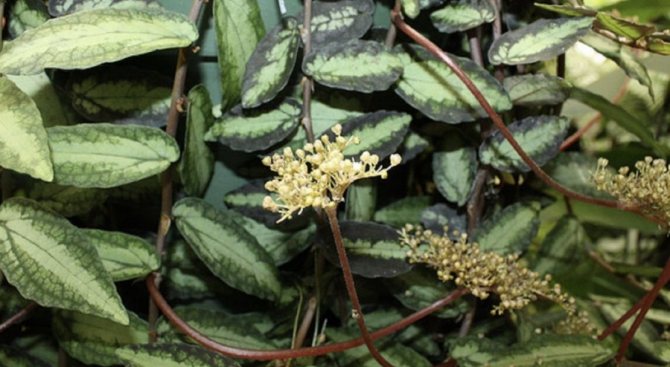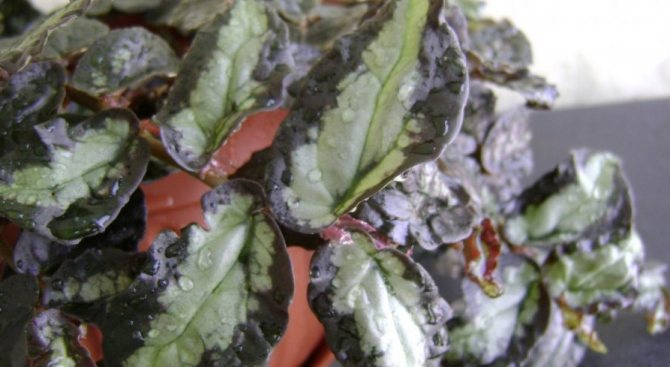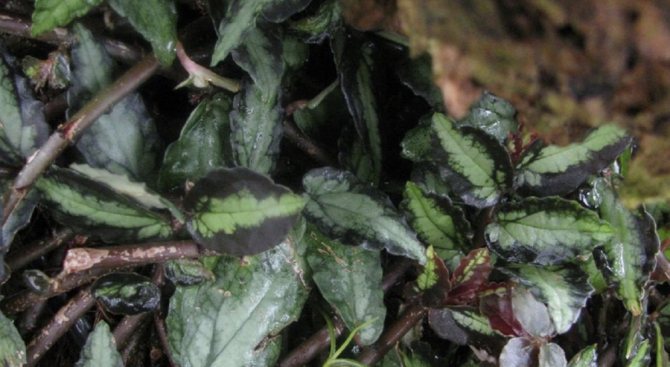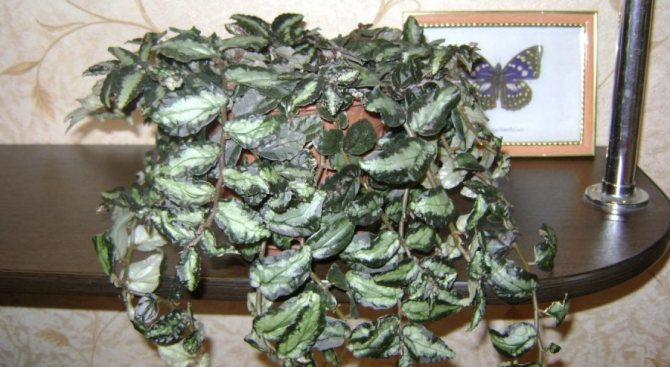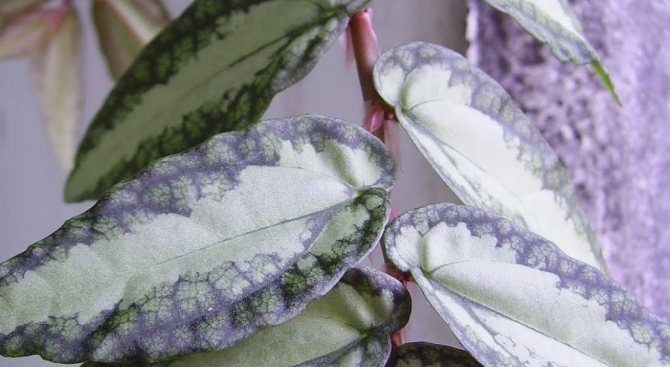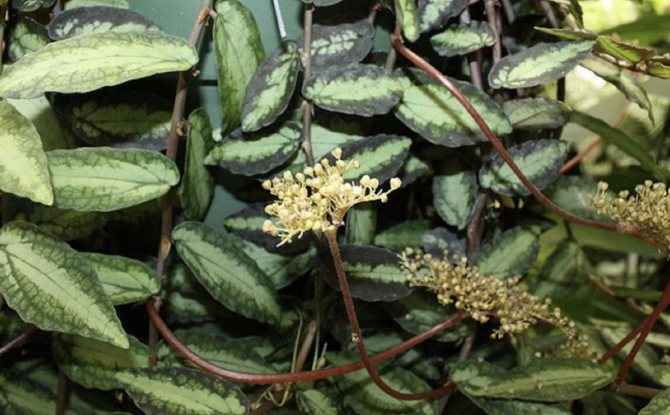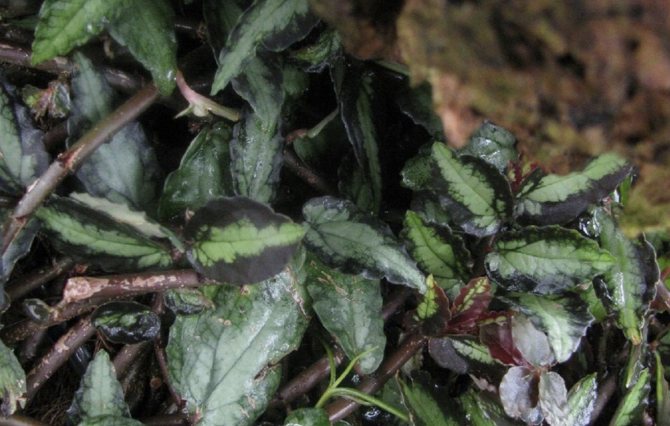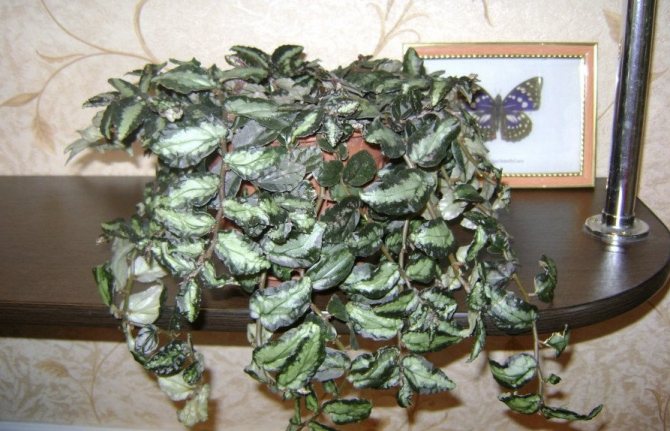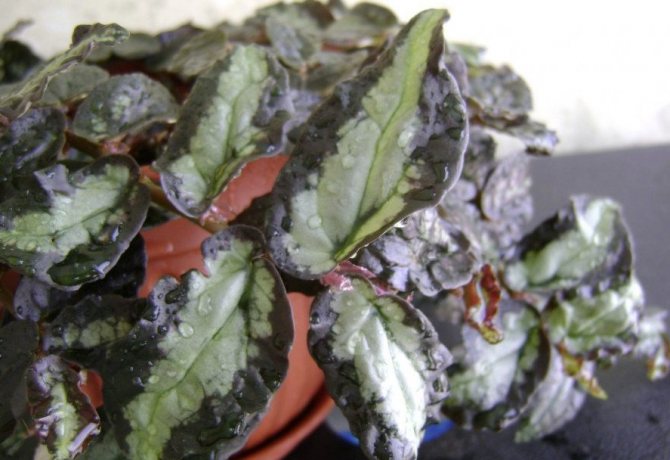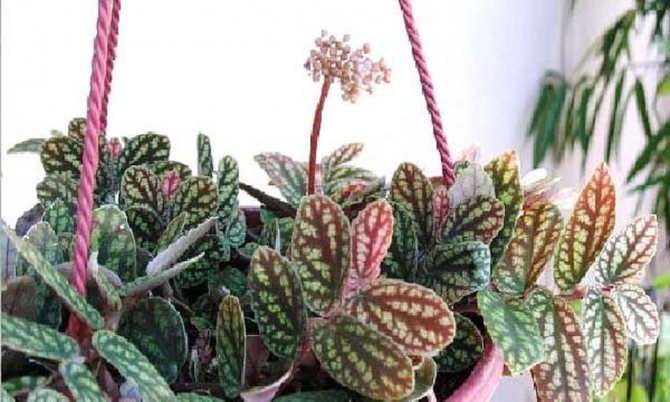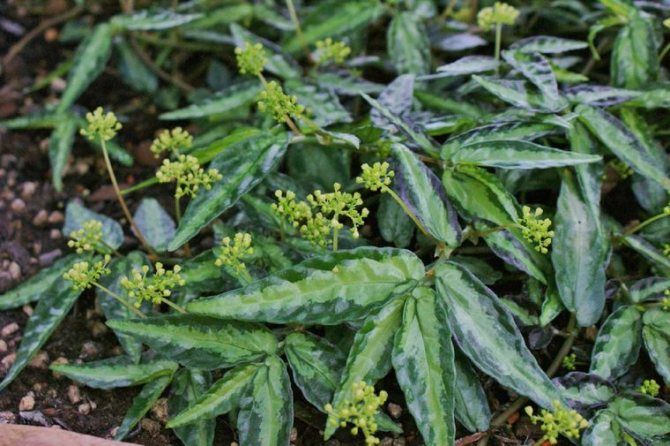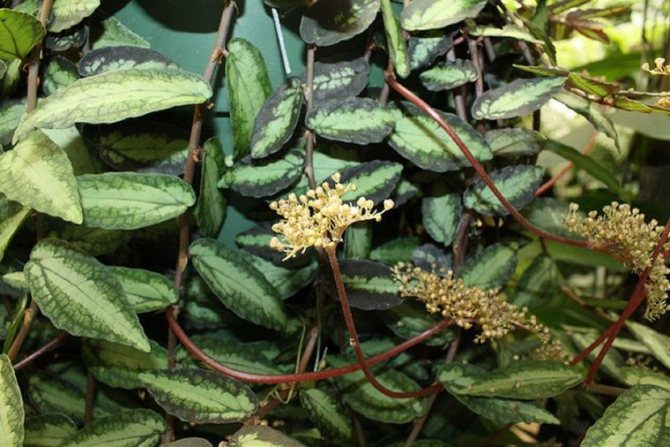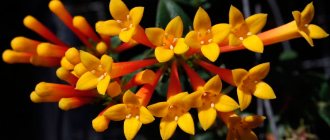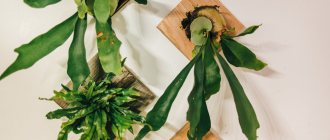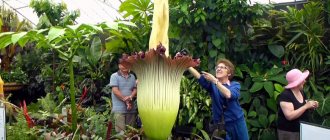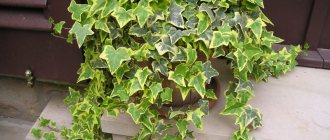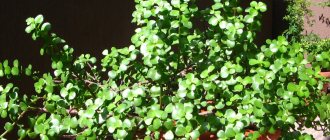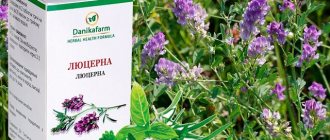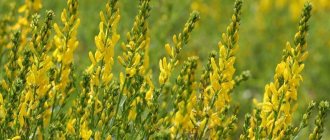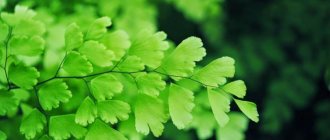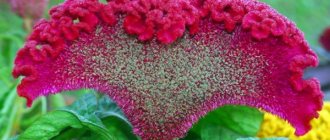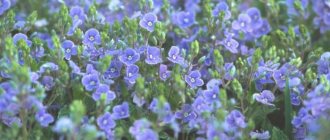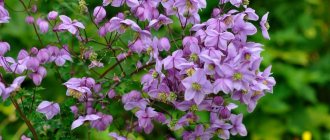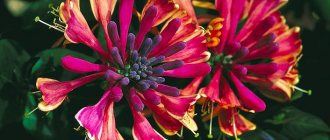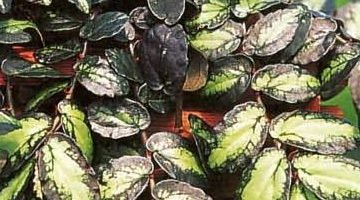
Pellionia Davo is a houseplant that deserves to be known.
A very rare houseplant from the Urticaceae family called Pellionia deserves much more attention from amateur flower growers. These plants are compact and highly decorative with their leaves. In addition, they do not cause unnecessary trouble for their owners.
Pellionia shown in the photo is a herbaceous creeping plant with creeping, brownish, succulent shoots branching from the base, pressed to the ground, and with oval leaves, olive-green with purple-brown spots along the edge. It blooms with flowers collected in a panicle. Pellionia is a plant of the nettle family. It grows naturally in East Asia. Pellionia Davo is a thermophilic plant. She does not tolerate overdrying of the soil. She needs regular abundant watering and frequent spraying. Propagate Pellionia by apical cuttings. Pellionia Davo is good and will be beautiful in a hanging planter like an ampelous plant.
This genus is named after A. Pellion, one of the participants in the circumnavigation in the early 19th century. It includes about 50 species of herbaceous plants, less often shrubs, common in the tropics and temperate regions of East Asia and Polynesia.
In indoor floriculture, two types of this plant are popular. One of them - Pellionia Davo, grows wild in East Asia, including China.
Description of the plant
Pellionia belongs to the genus of the same name in the Nettle family. The genus is dominated by herbaceous, ground cover species, but there are also semi-shrubs. The maximum height does not exceed 30 cm. The plant has a superficial, fibrous root system. Above the ground are soft, succulent stems. They can be painted bright green, pinkish or lilac.
Alternate leaves are attached to the stems with short reddish cuttings. An oval or ovoid leaf blade has smooth or slightly serrated sides and a pointed edge. Embossed veins are visible on the surface of the foliage. Leathery leaves are colored green, bronze or gray-silver. The edges of the foliage are darker, burgundy brown.
Pellionia blooms in the summer. It releases small umbellate or capitate inflorescences from the leaf axils. The buds have five bell-shaped petals. They are white-green and small in size. Foliage attracts much more attention than nondescript flowers. After flowering, dense seed pods are formed, in which oval seeds with a light smooth skin ripen.
Description of Pellionia
Pellionia is a herbaceous shrub that has thick, branched stems of a light brown color. The surface of the shoots is smooth, covered with elongated-ovate leaves of different colors, up to 6 cm long. A wide light line runs in the middle of the leaf plate. The edges of the leaf are bordered by a black stripe. Flowering is observed in the middle of summer. The flowers are small, white-green in color, collected in inflorescences, which are held on peduncles of medium length. Due to the inconspicuousness of the flowers, they are often cut off so as not to spoil the appearance of the bush.
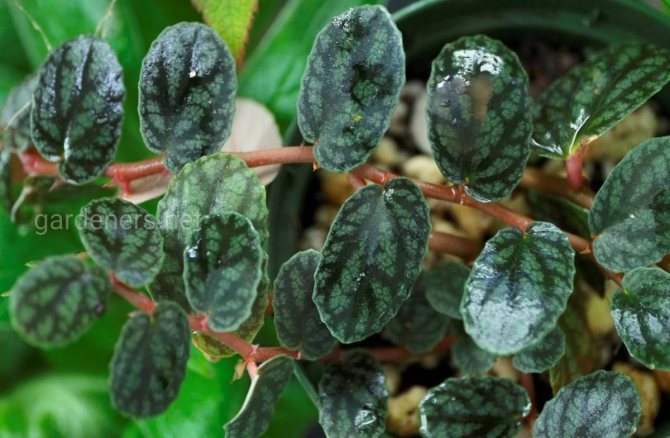

Home care
After purchase, the plant is washed under a tap of water.Then they are transplanted into other, more free containers. The flower can grow as a cover plant or ampelous. The cover is installed on coffee tables, window sills.
Ampelnoe - can grow in pots, cabinets, bookshelves. Growing in hydroponics is allowed. Very often this plant can be found in florariums, gardens, flower greenhouses. The plant looks great alone or surrounded by other flowers.
Pruning
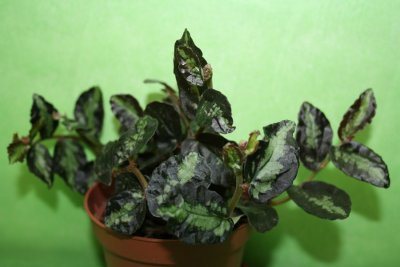

Sometimes the top can be trimmed. Thanks to this procedure, the dweller will not go to the sides. A spreading wide bush is formed.
The cut stems can be used for propagation. Therefore, pruning is carried out in the spring after the plant wakes up from a dormant period.
Watering
Watering should be systematic and regular. Do not allow the earthen coma to dry out. With a lack of moisture, the flower may die.
The most optimal watering option is a slight drying out of the upper part of the earth.
Sometimes the flower is sprayed with water from a spray bottle.
Landing
Since the root system of the plant is small, it is necessary to use shallow and wide containers. Then Pellionia can be a ground cover plant. In this case, a magnificent "carpet" appears. If the root system is the largest and cannot be used for covering, the pet is planted in deep containers. You can use pots, vases, or wooden pallets.
Ampel cultivation allows the plant to grow in pots. In this case, the flower is placed just below the eyes of the beholder. Then it will be visible not the seamy side of the leaves, but the front. Fill half of the container with a drainage system. Pebbles or expanded clay will do.
Diseases and pests
May be affected by aphids and whiteflies.
For prophylaxis, an ornamental bush is sprayed under a stream of warm water. You must first cover the roots with a plastic bag. Whiteflies look like powdery pollen. At the first symptoms of damage, chemical methods of control are used. Preparations work well Pegasus, Aktara, Confidor, Fitoverm, Arrivo.
If aphids are affected, the infected areas are removed. The plant is treated with oil products. Poisonous drugs can be used. After processing, the plant should be covered with a small film.
Due to the fact that the plant is shade-loving, too bright light may be the main reason. It is also necessary to reduce or increase watering, remove the flower from heating devices, or transplant more fortified acidic soil.
Pellionia types
The genus of Pellionia has about 50 species, but only a few of them can be bought and grown in culture.
Pellionia Davo. The plant has creeping, strongly branched stems at the base. The reddish branches are slightly thickened and covered with smooth skin. The alternate short-petiolate leaves of Pellionia reach a length of 6 cm and have an oval shape. The foliage, asymmetric with respect to the central vein, is colored bright green. A lighter wide stripe runs in the center. The outer surface of the sheet plate is glossy, and the reverse side has a rough surface and reddish stains. In the leaf axils in summer, rare, inconspicuous inflorescences are formed.
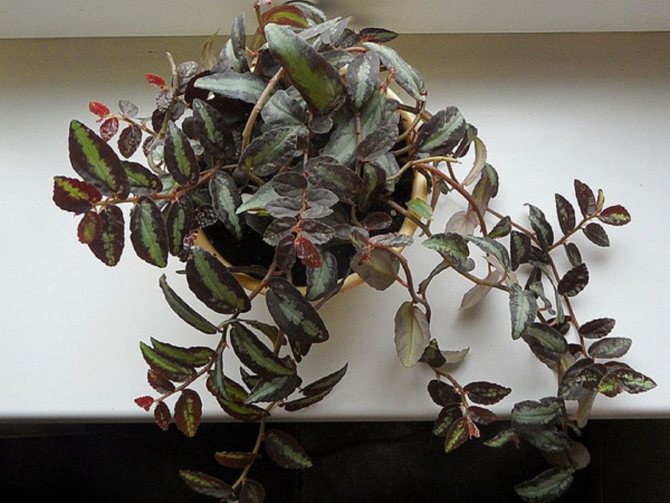

Pellionia Davo
Pellionia is beautiful. The plant has smaller leaves. Their length does not exceed 4 cm. The glossy surface of the leaf plate has a lighter central part and dark, sometimes brown-burgundy edges. Stripes and streaks resemble a marble pattern. The underside of the leaves is covered with a short hair and is colored silvery pink.
Pellionia Davo and her photo
Pellionia Davo (Pellionia daveauana) is a perennial herb with creeping shoots branching from the base, the stems are naked, brownish, juicy.Like many decorative leafy plants, Pellionia flowers are inconspicuous. But the leaves of this plant are very attractive: ovoid or broadly lanceolate, slightly asymmetric, greenish-brown top with a satin sheen, with a lighter stripe along the midvein, grayish-green below with a reddish tint. At the base of each leaf there is a pair of reddish membranous stipules. Grows in tropical rainforests, on rocks. Look at the Davo Pellionia in the photo, where a variety of specimens are presented:
Reproduction methods
Reproduction of Pellionia is possible by seed and vegetative methods. For seed propagation, seeds that are 1-2 years old are used. Vesta they are sown in bowls with a wet mixture of sand and peat. The seeds are deepened by 1-1.5 cm. It is advisable to cover the pot with foil or glass so that the soil does not dry out too quickly. Seedlings appear within 10-12 days. Young plants are grown without shelter until two true leaves appear. The grown seedlings are dived and transplanted into small pots, 2-3 pieces each.
It is convenient to use the method of rooting cuttings. It is enough to cut the stem into pieces with 2-4 leaves. Cuttings are left in a glass of water until young roots appear. The seedlings are then transplanted into soil pots and grown as mature plants.
You can root the segments directly in a wet sand-peat mixture. In this case, the bottom leaf is removed from the stem and deepened by 1-1.5 cm. A cap is erected over the cuttings so that the moisture does not evaporate too quickly. The greenhouse is kept in a warm room with an air temperature of + 22 ... + 24 ° C. The seedlings take root very quickly and can grow normally without shelter.
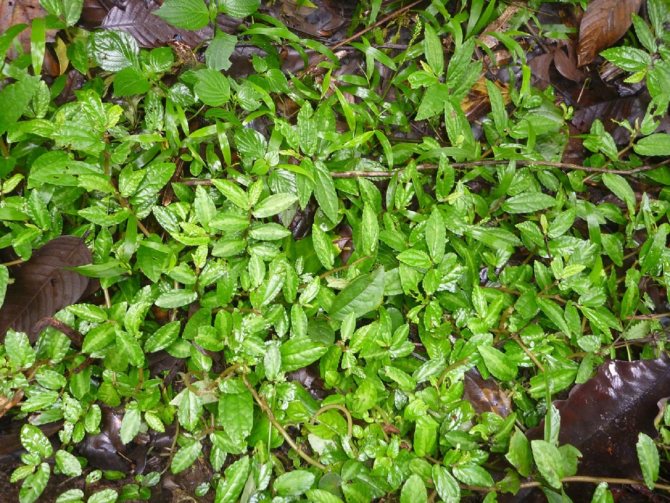

Reproduction
The culture is propagated by seed or vegetative method. At home, Pellionia is divided by cuttings. Upper shoots are used as seedlings.
There should be three petioles on the handle. Plant the shrub in loose soil, water the soil, then your cutting will take root in seven days.
Diseases and pests
The plant has good immunity. It can suffer from poor water, dry soil, or stagnant liquid in the roots. Then the roots can rot, the leaves turn yellow, wither. To avoid illness, follow all the rules of care.
Aphids or whiteflies can settle on the leaves. To prevent these pests from spoiling Pellionia, water it regularly with warm water.
Where is applied
At home or in greenhouses, Pellionia is used in compositions, flower beds, indoor gardens. It is grown in hanging pots or tubs, and as a living carpet in gardens. In flower beds and gardens, Pellionia is planted next to flowering crops, as a ground cover plant.
Photo
Photos of home-grown Pellionia:
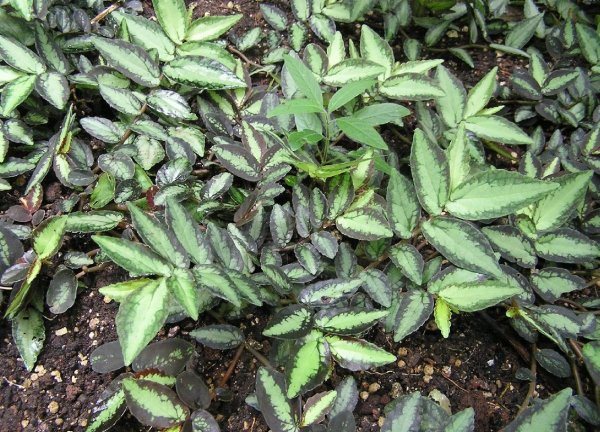

What does Pellionia look like?
This perennial evergreen plant most often has creeping shoots and a superficial fibrous root system. Stems that branch strongly at the base of the plant, as a rule, are not higher than 50 cm.
Pellionia is valued by flower growers for decorative oval-shaped leaves of green, gray, silver or bronze color (sometimes with a marble pattern), with a brown-burgundy edging.
This plant blooms with small white flowers, similar to bells, which are collected in capitate or umbellate inflorescences.
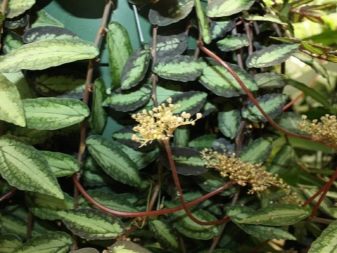

Application of Pellionia
Pellionia is an ornamental plant that looks great in combination with other crops in group plantings and compositions located in terrariums and florariums and can act as a ground cover representative of the flora. Floral designers use Pellionia to decorate a bottle garden and also recommend it as an ampelous plant. Indoor flowers with an unusual color of leaves, planted in hanging pots, will make the room cozy and pleasant to spend time with.
Description
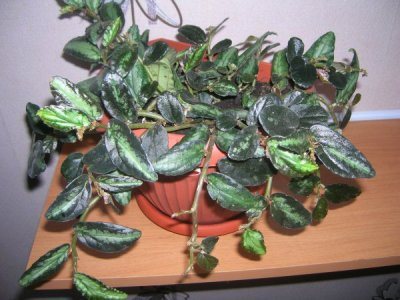

Refers to the subspecies of nettles. But unlike nettle, it is harmless.Does not burn on palpation. It is a perennial.
Grows in the form of shrubs or herbaceous ornamental plants. Creeping stems.
Leaves of various shapes and sizes. The edges can be serrated with slight serration or completely one-piece.
The flowers are very dense. Collected in a capitate or umbellate shape. In total, there are about 50 different subspecies.
Originally, this plant grew in Asia on the Pacific coast. The plant is used as a ground cover, in the form of a small lawn or as an ampel plant.
Care rules
Pellionia care is not difficult even for novice florists. This flower is very unpretentious and pleases with lush vegetation. Pellionia pots are placed in bright rooms away from windows. Direct sunlight causes the foliage to dry out and shed. In winter, in the northern premises, Pellionia can suffer from a lack of light. If the leaves have turned pale, you must use a lamp.
In summer, the temperature should not rise above + 25 ° C. On hot days, it is recommended to take the plant out to a shady garden. The place is chosen quiet, windless. In winter, cold snaps up to + 16 ° C are allowed, but it is not necessary to specially arrange a rest period for the plant.
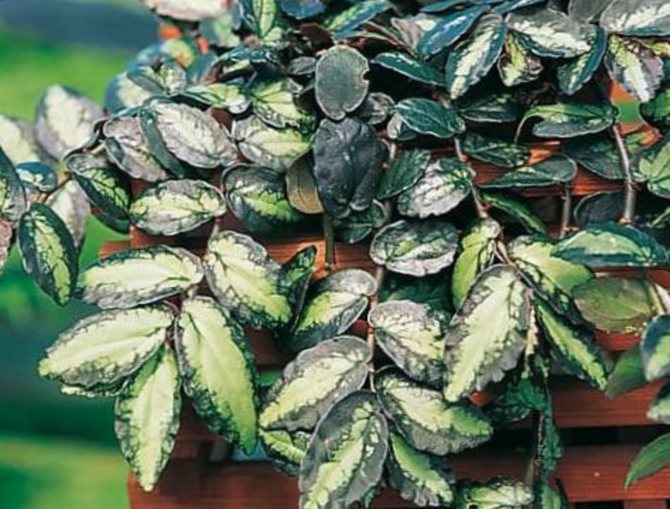

It is important for a dweller in the humid tropics to maintain high indoor humidity. The indicator should be at the level of 70%. It is necessary to regularly spray the leaves, turn on a humidifier or arrange trays with wet expanded clay. Water containers must be isolated from the ground.
Pellionia needs frequent and abundant watering. The plant prefers soft, purified water. It is important to make sure that excess liquid leaves the pot freely. The pallet must be emptied half an hour after watering. Otherwise, root rot may develop and the plant will die.
No more than once a month, a complex fertilizer for indoor plants is added to the water for irrigation. It is impossible to use dry or concentrated fertilizer, so as not to burn the roots. Compositions with organics are welcome, they will make the leaves brighter.
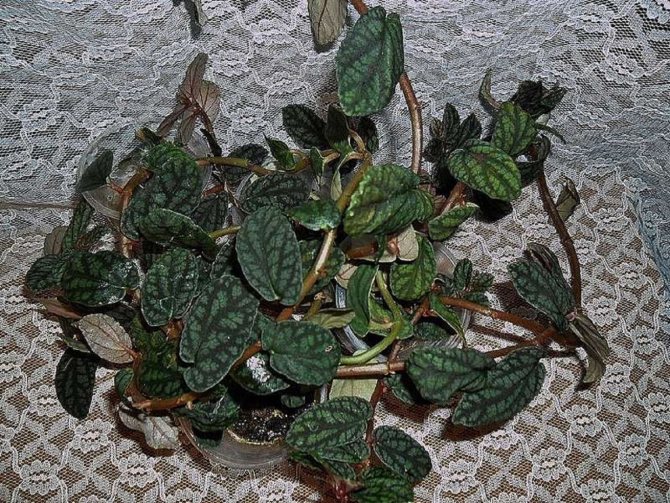

It is useful to replant Pellionia every 1-2 years, as it grows strongly. The procedure is carried out in the spring, the pot is chosen a little more than before. The roots should be carefully removed from the old earthy coma. For planting, use a soil mixture from:
- peat;
- leafy land;
- leaf humus;
- sand.
You can buy garden land at a flower shop. The substrate must be acidic, so it is recommended to increase the amount of peat in the soil.
Pellionia loses its decorative properties after 5-8 years of life. Its stems are elongated, and their bases are bare. It is recommended to trim the edges of the stems annually to maintain the attractiveness of the crown and increase bushiness. Periodically, the plant is rejuvenated by cutting new petioles.
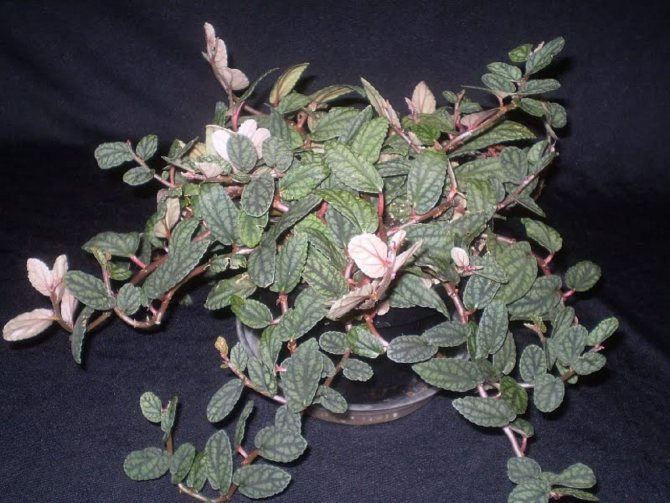

Growing difficulties
The causes of most diseases of indoor plants lie in the violation of conditions of maintenance and rules of care. For example:
- Dry leaf tips - from dry air and low humidity;
- Rotting roots and root collar - from an excess of irrigation water;
- Pale leaves - from excessively bright lighting;
- Elongated stems - from lack of light.
[collapse]
Beneficial features
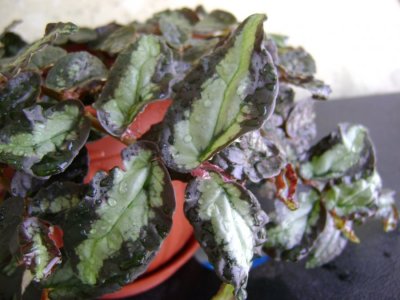

Pellionia perfectly cleans the air, saturates it with phytoncides. Kills pathogens and microorganisms. Revitalizes the indoor atmosphere.
Sometimes an ornamental shrub is used in cooking. Soups are cooked, added to borsch, salads.
But the plant should not be consumed by people with intestinal diseases, gastritis and ulcers.
Earth mixture
Needs light and nutrient-rich soil. For planting, a commercially available universal flower soil is suitable, into which you should add a small amount of a baking powder, for example, such as vermiculite, perlite or brick chips.You can also make a soil mixture with your own hands, for this by mixing humus, leaf and peat soil, as well as coarse sand in a ratio of 1: 2: 1: 1.
Flower pots are low and wide because the root system is close to the soil surface. Don't forget good drainage.
Can grow hydroponically.
How to grow a flower
Exists two breeding methods of pilligonia... The first is with the help of seeds. And the second - cuttings.
In order to grow in the first way, you need to wait until the plant reaches two years. After flowering, you need to collect the seeds that have appeared. For planting, moist soil is suitable, consisting mainly of peat and sand in equal quantities.
The seeds must be evenly distributed over the substrate. Then you need to cover the container with foil. It will take about ten to twelve days before shoots form on the surface.
As soon as two or three young leaves appear on each, the plants must be planted in separate pots.
Cutting is considered an easier method. The first thing to do is cut off a few cuttings. After - put in water and leave there until roots appear. As soon as this happens, you can land them in separate containers to carry out all the procedures with them.
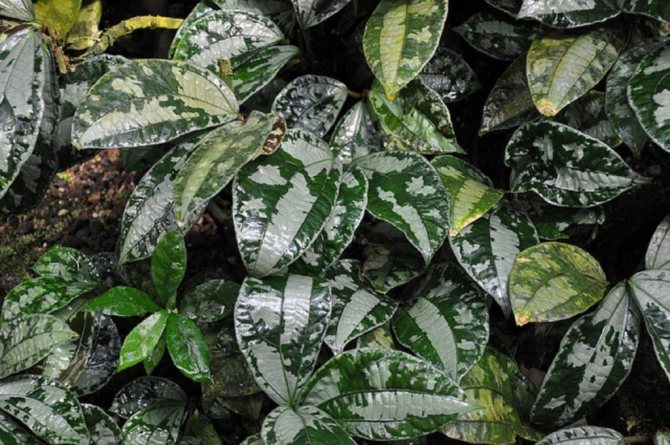

Photo gallery
Pellionia - ampelous shade-tolerant plant with marble foliage
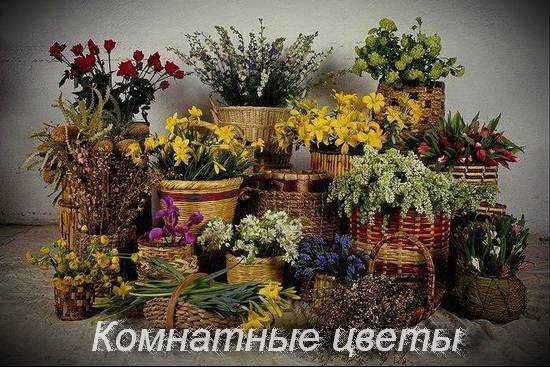

Family Urticaceae - Nettles.
The genus Pellionia is Pellionia.
Rainbow Vine, Trailing Watermelon Begonia, Satin Pellionia.
Pellionia - plant care, planting and transplanting, reproduction, species and varieties.
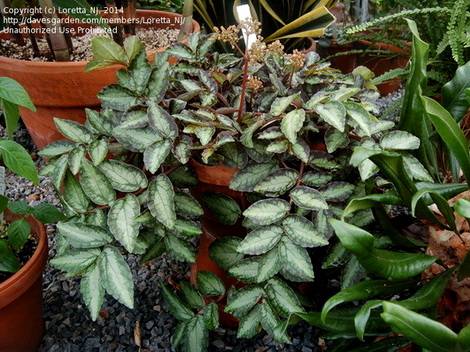

Pellionia, origin and appearance.
Evergreen perennial herbaceous plants and shrubs, widespread in the tropical and subtropical regions of Southeast Asia, the Pacific Islands. Modern DNA analysis shows that the genera Elatostema, Pellionia and Pilea can be combined into one genus. Stems are juicy, pinkish or lilac, creeping, pressed to the ground. They branch strongly at the base and usually do not exceed 30 cm in height. Superficial fibrous root system. Its fleshy, brittle stems thrive in moist soil, and its dense leaves create a vibrant carpet of exceptional beauty.
The leaves are alternate, thin, purple-brown, of various shapes and sizes with a pointed edge, with light stripes along the central vein, abundantly cover the stems. Embossed veins are visible on the surface of the foliage. The edges can be serrated with slight serration or completely one-piece. Attached to the stems with short reddish cuttings.
The flowers are collected in a capitate or umbellate shape. It blooms rarely, the flowers are small, white bell-shaped with five petals. Blooms in August. Home-grown plants tend to be pruned. Foliage attracts much more attention than nondescript flowers. After flowering, dense seed pods are formed, in which oval seeds with a light smooth skin ripen.
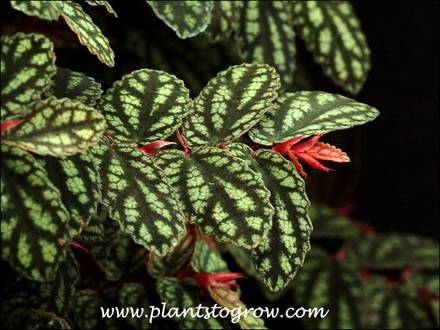

Pellionia, care and maintenance in room conditions.
This plant is prized for its variegated marble foliage. Their coloration ranges from green to bronze and silvery gray, with more or less dark veins. It can grow as a ground cover plant or ampelous. Shoots can be up to 50 cm in length. The cover is installed on coffee tables, window sills. Usually used as an ampelous plant - it can grow in wall pots, hanging baskets, in this case the flower is placed just below the eyes of the beholder. So that the leaf pattern is visible both with a beautiful part on the outside and on the inside. Very often this plant can be found in florariums, gardens, flower greenhouses. The plant looks great alone or surrounded by other flowers.
This flower is very unpretentious and pleases with lush vegetation.Cultural species that grow indoors grow rather slowly. Its young leaves are very fragile, break easily, detach from the petioles. Therefore, you need to handle the plant very carefully. The plant does not have a pronounced dormant period, it grows all year round. In a pot culture, it rarely blooms. Grows well in shade. Prefers good feeding, windless premises. Dislikes frequent transplants.
While Pellionia is young, it is imperative to pinch to form a more lush crown. Sometimes it is necessary to trim the upper part of the elongated shoots (leave shoots 8-10 cm long). Thanks to this procedure, the plant will not grow up, but to the sides, and forms a spreading wide bush. Pruning is carried out in the spring, the cut stems can be used for propagation. The plant grows quickly and loses its decorative effect, and since young leaves have a high decorative effect, the plant will have to be regularly updated with cuttings every 2-3 years.
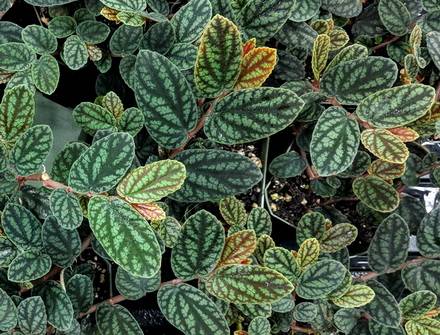

What should be the coverage of Pellionia.
The ornamental bush grows well in the depths of the illuminated room; it can be placed no further than 1 meter from the window. Can be placed on cabinets, tables, bookshelves. Bright diffused light, east, west, north, northwest windows are suitable, or on a shelf not far from the south window, can also be grown under artificial lighting. It reacts negatively to direct sunlight, the leaves darken and curl.
In winter, due to lack of light, the flower can be moved closer to the window, but not placed near a hot heating battery and make sure that the leaves do not touch the cold glass. With a lack of light, the pattern on the leaves loses its brightness.
Optimum temperature.
In summer, the optimum temperature is from 20 to 24 degrees, and in winter it can vary between 17-19 ° C. The flower does not like excessive heat, as well as strong temperature changes. Do not keep it near hot radiators. In dry hot air, the plant quickly loses its decorative effect. The leaves begin to turn yellow and fall off. Quite sensitive to low temperatures, if the window sill is cold in winter, then you should put the pot on an insulating stand, or hang it higher. When the temperature in the room drops, watering must be reduced, otherwise there is a danger of decay of the delicate roots and base of the stems. Fresh air is useful, but not drafts. In summer, you can take it outside in a shady place.
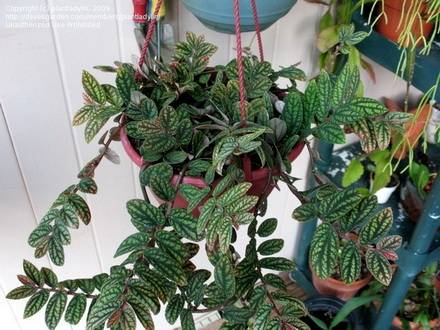

How to water Pellionia.
The most optimal watering time is a slight drying out of the upper part of the earth. The soil in the pot should be constantly moist throughout the year, but not waterlogged. However, a lack of moisture leads to leaf fall. The drying out of the root ball will lead to drying and falling of the leaves. Water it with soft, boiled water. In winter, watering is limited and the abundance of watering is reduced. Excess moisture in combination with low temperatures can cause rotting of the roots and death of Pellionia.
Air humidity.
Increased air humidity is needed. She gets used to ordinary room air, but does not tolerate the dry air of city apartments, she has a very positive attitude towards spraying. If you place a pot of Pellionia on the windowsill, you will often have to spray the leaves and increase the humidity of the air, especially in winter, in any other way.
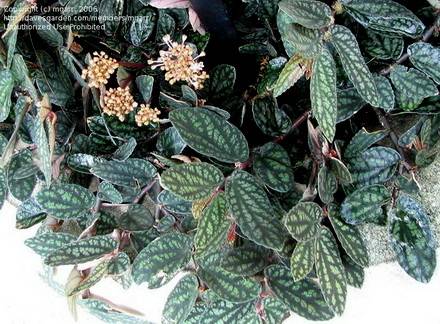

Feeding Pellionia with fertilizers.
The plant needs systematic infrequent feeding. You can feed the flower once a month. Preparations for indoor decorative flowers are well suited. From organic fertilizers, the color of the leaves appears more vividly. When using top dressing, it is recommended to halve the concentration of the drug recommended on the package.In winter, feeding is stopped.
Pots for Pellionia.
The pots should be shallow, since the root system of the plant is shallow. When using tall dishes, it is imperative to fill about a third of the pot volume with drainage. When choosing baskets, it is advisable to give preference to plastic or made of hardwood. Otherwise, they will quickly rot.
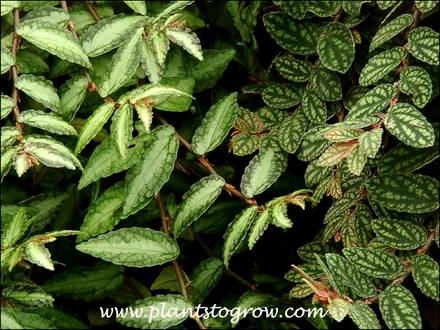

In what substrate is Pellionia planted.
A slightly acidic, well-drained, nutritious, light earth is needed. For planting, a universal flower soil is suitable. It is advisable to add peat, a small amount of vermiculite, perlite to the ground. Fern substrate can be used.
Landing and transplanting Pellionia.
You can transplant from spring to autumn. Pellionia is regularly transplanted into large flower pots, picking up wide, but shallow dishes. When transplanting, several stems are pinned in the center of the flower pot to mask the bald spot that forms here over time. The transplanted plant is placed in a shady and warm place for several days.
Pellionia grows quickly and loses its decorative effect over the course of two years. Therefore, it is often grown for a couple of years, and then new cuttings are rooted. Given the ease of reproduction of Pellionia, a new plant can always be grown.
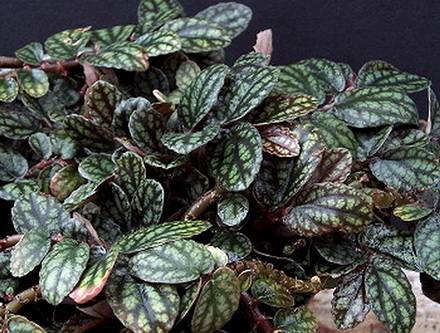

Reproduction of Pellionia by division.
Can be propagated in summer by dividing the plant, each part must have roots.
Propagation of Pellionia by cuttings.
The tops of shoots 10 cm long root better. You can also use stem cuttings. It is important that the stalk has at least three internodes. Cuttings are immersed in water or a wet substrate from a mixture of peat and sand until the root system appears. Within 2-3 weeks, give the roots in boiled water. Then they are planted in the soil. I cover it with cellophane or a glass jar and keep it in a warm room with an air temperature of 22-24 ° C. Ventilate periodically. After complete rooting, they are transplanted into pots for permanent residence. It is advisable to plant several cuttings in one pot at once.
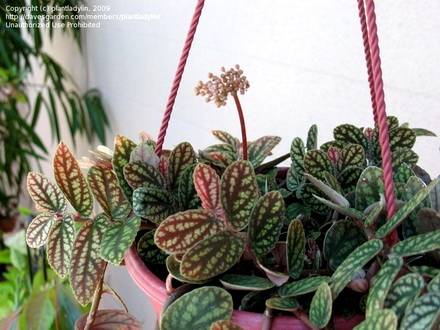

Reproduction by layering.
It can be propagated by layering: next to a large pot with the mother plant, small pots with loose soil are placed, and the longest shoots are pinned to the soil surface in small pots. The cuttings take root very quickly, after which they are cut off from the mother plant.
Reproduction by seeds.
After flowering, you can harvest the seeds. For seed propagation, seeds that are 1-2 years old are used. The seeds are kept in a growth promoter. After this procedure, their germination increases. In spring, they are sown to a depth of 1-1.5 cm in wide shallow bowls with a wet mixture of sand and peat. Then the soil is sprayed with a spray bottle and covered with foil or glass. Ventilate periodically. Seedlings appear within 10-12 days. After at least 3-4 leaves appear on the sprouts, they dive and transplant into small pots 2-3 pieces each.
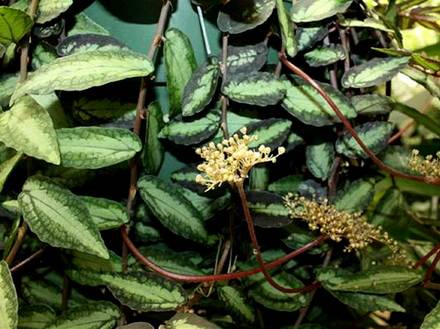

Diseases and problems in the care of Pellionia.
The tips of the leaves dry out in dry air.
Stems can rot at the base if the humidity is too high, at low temperatures, or in insufficiently acidic soil.
With a lack of light, the shoots stretch out, turn pale, the internodes increase, the shoots die off.
The leaves darken, wrinkle, their edges curl up - too bright sunlight.
The tips of the leaves dry out in Pellionia. The reason for this is the same dry air.
As a result of excessive watering, the root collar begins to rot. In this case, there is a high probability that the plant can no longer be saved.
Popular types and varieties of Pellionia.
In indoor floriculture, mainly two species are bred: Pellionia daveauana and Pellionia pulchra.
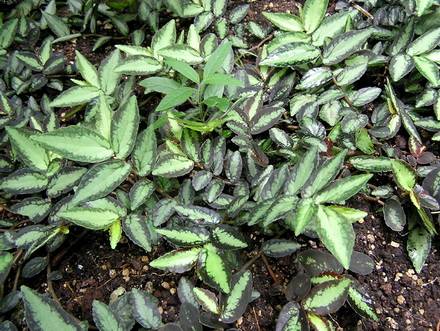

Pellionia daveauana - Pellionia Davo... (Rainbow Vine, Trailing Watermelon Begonia). Synonym: Pellionia repens - Creeping Pellionia.Perennial herb with bare, brownish, rather thick, creeping shoots branching from the base. Roots are formed on the stems in places where the nodes touch the soil surface, due to this, a fairly rapid growth occurs in all directions. Unpretentious shade-tolerant, ampelous plant. Looks beautiful in a hanging planter. It can be successfully used as a ground cover.
The leaves are alternate oblong or rounded, slightly asymmetric, the bases are heart-shaped, the tops are pointed, greenish-brown above with a satin sheen, with a lighter wide pattern along the midrib, rough below, grayish-green with a reddish tint, up to 4-7 cm in length ... And along the edge of the leaves are painted in a dark, almost black, shimmering purple color. The surface of the leaves is smooth, slightly gorbate. At the base of each leaf there is a pair of reddish membranous stipules. The cuttings are short.
The flowers are small, white-green, inconspicuous, collected in loose inflorescences in the form of umbrellas. Home-grown plants tend to be pruned. The plant is shade-tolerant, the distance between the leaves that have grown over the winter is the same as that of the spring growth. The size of the foliage changes depending on the light and, accordingly, the color becomes brighter. Loves spraying. Pellionia Davo requires an annual transplant.
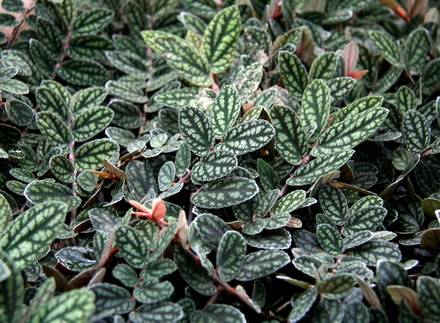

Pellionia pulchra - Beautiful Pellionia... (Satin Pellionia). Homeland - the tropics of Southeast Asia. Moisture-saturated air, diffused light and a constant high temperature - this is the environment in which Pellionia grows in its homeland. Perennial herbaceous ground cover plant. It has a smaller leaf size compared to Davo's Pellionia. Fleshy, brittle, creeping stems of the plant grow on the subtray and form a thick carpet of leaves.
The leaves are smooth, shiny, obtuse, up to 3-4 cm in length, on the gray-silvery front side of the leaf there are dark green stripes and marble streaks along the veins. The seamy side is grayish-pink, covered with a short nap. Small white-green flowers, collected in loose inflorescences on small flower stalks in the form of umbrellas and do not represent any decorative value. Peduncles are usually cut off. Heat-loving, grows well in the shade.
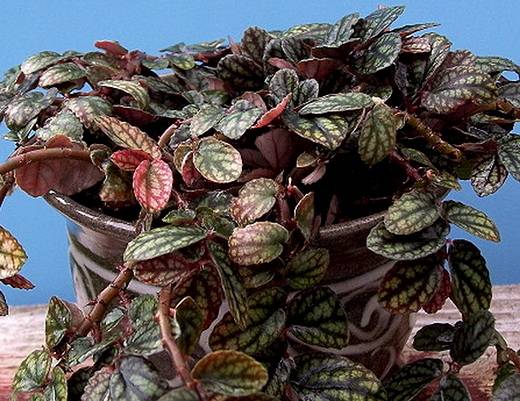

Bloom
All types of Pellionia form tall peduncles in the summer. Umbrella inflorescences are retained, if desired, to obtain seeds for reproduction. At the same time, it is useful to additionally feed the plant, monitor the conditions necessary for the formation of leaves.
Decorative properties are not used to create flowering compositions for indoor floriculture.
In the photo, the flowering of Pellionia:
Transplant and pruning
If the crown is not formed, its shape is not corrected and growth is not controlled, it will not look lush and decorative. This is especially true of young, newly planted specimens. Shaping is done by pinching the tops of the stems to stimulate the formation of lateral shoots.
As for the transplant, the peculiarity of the culture is its rather rapid growth. The bush quickly loses its decorative appearance, therefore, instead of transplanting, it is recommended to rejuvenate it by planting cuttings or cuttings.
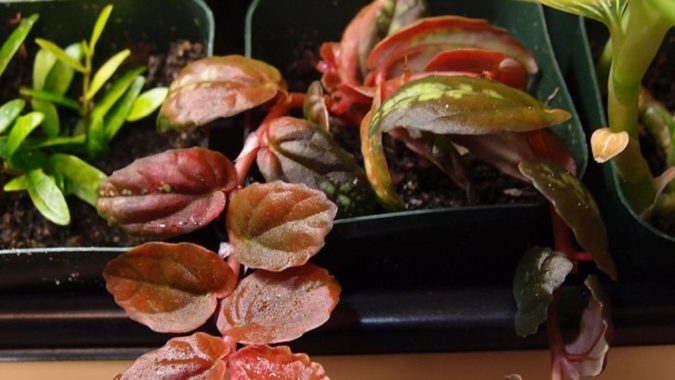

It is recommended to place this flower in the interior in such a way that it is below eye level, otherwise all the beauty of its variegated foliage loses its meaning.
Reproduction of Pellionia.
Pellionia can be propagated both by dividing the bush and by cuttings. When transplanting, you should carefully separate part of the bush and plant in a suitable container.
It is best to use apical cuttings to get a new plant.
The main pests of Pellionia are whiteflies and aphids. Cold and dry air can be detrimental to Pellionia. Improper care will lead to the rapid death of this beautiful plant.
Houseplants catalog with photos and descriptions. Read on - peperomia, an excellent ornamental plant for the home.
Video review
Pellionia is a perennial evergreen with decorative colorful foliage. The marble pattern on delicate leaves attracts many flower growers, and even beginners will like the docile nature. Pellionia as a houseplant is grown in pots, although at home, in Malaysia or Burma, it is a creeping ground cover beauty with beautifully hanging vines.
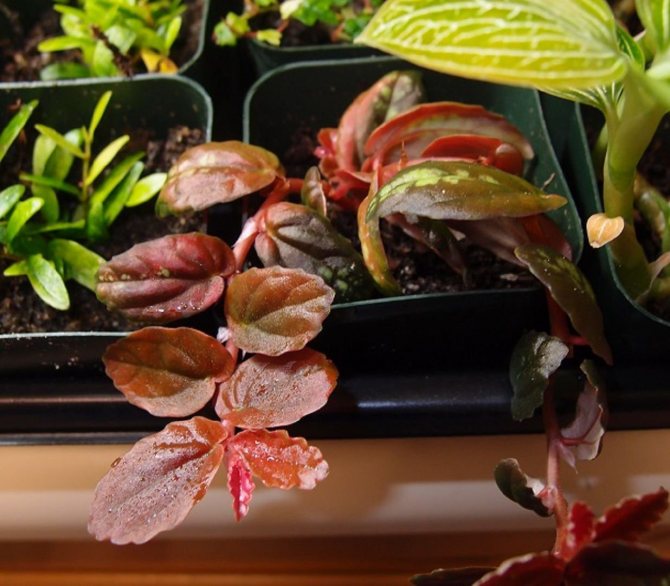

Pellionia placement indoors.
Pellionia is a shade-tolerant plant, but it is best placed in partial shade. The second condition for the normal development of Pellionia is warmth.
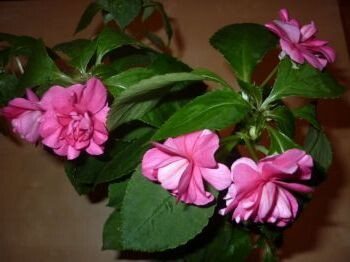

The room temperature should be around 17 ° C. At rest (in winter), 12 ° C is sufficient, but not lower.
The best place to keep Pellionia is in the terrarium, where it is easier to create optimal conditions.

